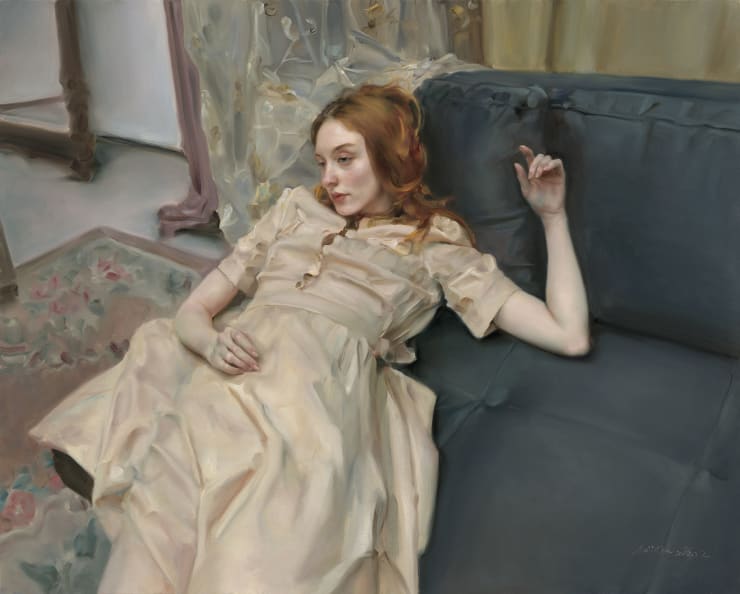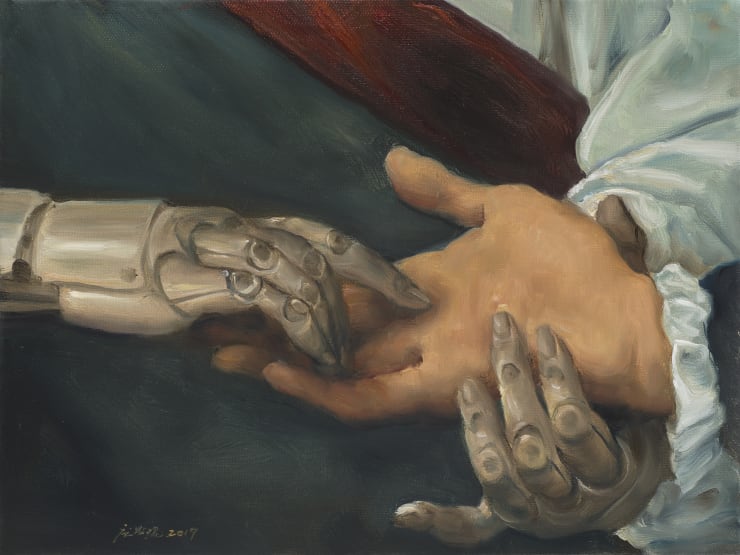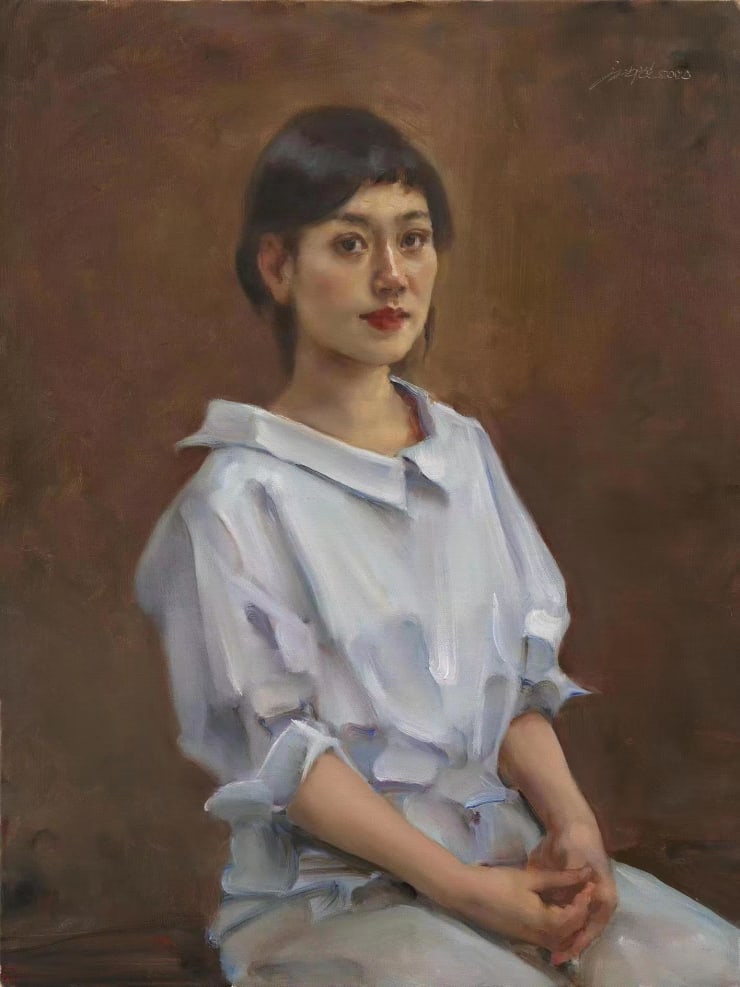Viewing, Gazing and Presence : Pang Maokun
In the middle and late stage of 1980s, Pang Maokun devoted himself to the research and exploration of classic oil painting language. In his recent 40 years of creation, he is also a representative artist who maintains the most complete aesthetic temperament derived from classical language. In fact, when we talk about "classic", its essence has a broad extension, including not only language and creative methods, but also the mechanism of visual reproduction and viewing. As far as the language track of Pang Maokun's oil painting creation is concerned, the formati n of his classical road comes from at least three sources: first, thanks to good college training, he has superb realistic ability; Second, from concrete to image, and then to schema. The basic feature of this type of works is that with the help of the techniques of "misappropriation" and "juxtaposition" of postmodern art, artists "tamper with the picture structure and narrative mode of classic works in the history of Western art, which not only strengthens the expression of works' ideas, but also makes them have the schematic appearance of western classic paintings. Third, constantly inject new cores into realism. Therefore, language is the most important entrance into Pang Maokun's painting world. Along the channel of language, images, narration and landscape come one after another. Although starting from language, language is not the ownership of painting. For Pang Maokun, how to integrate contemporary people's visual experience, viewing experience and cultural experience into classical discourse is the real purpose. For classical painting, the formation of visual reproduction system and creating a unique viewing experience are very important. As we all know, since the Italian Renaissance, because of the invention of "perspective", it has become possible for artists to explore a new viewing mechanism. The purpose of "perspective" is, on the one hand, how artists give the painted objects visual order on a two-dimensional plane. On the other hand, it is to let the audience form a relationship between seeing and being seen with the picture, and finally let the audience be in it. Therefore, in order to maintain the integrity of the picture, painters in the classical period made the painting in a permanent state by creating a three-dimensional illusion space. At the same time, using focus perspective, the audience can find the visual center of the picture, and then be attracted by the story and plot of the picture. Therefore, when appreciating the works of classical masters, the audience first sees the content of the painting, and then a painting. It is from this perspective that the visual reproduction tradition constructed by classical art since the Renaissance once gave viewing the supreme right, that is, artists take the pursuit of perfect visual reproduction as the highest purpose. If we understand it from another perspective, the significance of works depends on viewing. Due to the influence of contemporary visual culture research and theory, especially in the context of contemporary painting, compared with the classical period, "viewing" has been given more meaning, such as gender, identity and culture, including the power behind seeing and being seen. In Pang Maokun's paintings of various periods, we will notice that the artist will carefully endow his works with an internal viewing logic. In his specific creation, Pang Maokun sometimes changes the characters and scenes in the painting by means of "misappropriation" and "Parody" with the help of the schema of classical works in the history of Western art, so as to present a new visual and picture order. Sometimes, artists will skillfully use the "mirror" to reveal the logic behind viewing. For example, represented by works such as live broadcast and marriage witness, Pang Maokun places the characters in a specific and daily environment. Because of the existence of the mirror, the visual mechanism of the picture essentially forms a dual viewing. One is that the characters and mirrors in the painting constitute the first level of viewing, and the other is the gaze from the artist. In fact, the power of "gaze" is far greater than that of "watch", because it can reflect the artist's keen insight and the spiritual depth when taking care of reality. Finally, when facing the completed paintings, the audience shares the artist's aesthetic and viewing experience. This time, some figures and portraits created by Pang Maokun in recent years are displayed in the thousand plateau art space. Most of the characters in the paintings are the artist's family, friends and colleagues. Among them, some works are live sketching. For these works, artists generally do not give too much explanation to the real scene, simplify the content in the background and abandon too many details. On the contrary, they try their best to capture the psychological and mental state of the characters under this situation. For artists, the so-called "presence" is essentially a "here" state of the characters in a specific scene, time and space. As mentioned above, when appreciating a classical painting, the audience first sees the content of the painting, and then a painting. In fact, classical painting needs not only viewing, but also a suitable viewing distance. Only in this way can the audience and works, works and walls be kept in a best state. Therefore, because of the viewing, the audience and the works form a visual mechanism, and the viewing behavior itself will bring a sense of ritual. In this exhibition, we hope to create a special viewing environment so that the audience's viewing will also become an important part of the significance of the works. In this sense, "presence" is also aimed at the audience.
-
 庞茂琨 Pang Maokun, 子夜 Midnight, 2015
庞茂琨 Pang Maokun, 子夜 Midnight, 2015 -
 庞茂琨 Pang Maokun, 斜倚的妮娜 Reclining Nina, 2020
庞茂琨 Pang Maokun, 斜倚的妮娜 Reclining Nina, 2020 -
 庞茂琨 Pang Maokun, 斜倚的妮娜 No.2 Reclining Nina No.2, 2020
庞茂琨 Pang Maokun, 斜倚的妮娜 No.2 Reclining Nina No.2, 2020 -
 庞茂琨 Pang Maokun, 邂逅一 Encounter No.1, 2017
庞茂琨 Pang Maokun, 邂逅一 Encounter No.1, 2017 -
 庞茂琨 Pang Maokun, 邂逅二 Encounter No.2, 2017
庞茂琨 Pang Maokun, 邂逅二 Encounter No.2, 2017 -
 庞茂琨 Pang Maokun, 命运 Destiny, 2019
庞茂琨 Pang Maokun, 命运 Destiny, 2019 -
 庞茂琨 Pang Maokun, 牵手 Hand in Hand, 2019
庞茂琨 Pang Maokun, 牵手 Hand in Hand, 2019 -
 庞茂琨 Pang Maokun, 小琼 Xiao Qiong, 2015
庞茂琨 Pang Maokun, 小琼 Xiao Qiong, 2015 -
 庞茂琨 Pang Maokun, 婉秋之二 Wan Qiu No.2, 2019
庞茂琨 Pang Maokun, 婉秋之二 Wan Qiu No.2, 2019 -
 庞茂琨 Pang Maokun, 小曹肖像之二 Xiao Cao No.2, 2020
庞茂琨 Pang Maokun, 小曹肖像之二 Xiao Cao No.2, 2020 -
 庞茂琨 Pang Maokun, 石柱女子 Shi Zhu Lady, 2020
庞茂琨 Pang Maokun, 石柱女子 Shi Zhu Lady, 2020 -
 庞茂琨 Pang Maokun, 沙发上的妮娜 Nina on couch, 2021
庞茂琨 Pang Maokun, 沙发上的妮娜 Nina on couch, 2021 -
 庞茂琨 Pang Maokun, 小辰 Xiao Chen, 2021
庞茂琨 Pang Maokun, 小辰 Xiao Chen, 2021 -
 庞茂琨 Pang Maokun, 白衣女子 Lady in white, 2019
庞茂琨 Pang Maokun, 白衣女子 Lady in white, 2019















